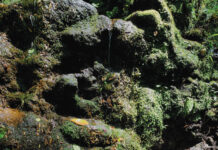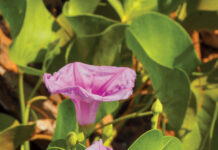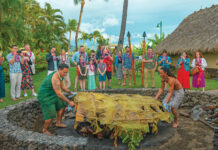Ashley Stepanek | Paintings by Herb Kawainui Kane | Photography by the Maui Historical Society
“The land rises for several miles through scattered households among groves of banana and many small fields of sweet potatoes and taro of the dryland varieties. Each field is bordered by rock, and along the walls are tall, feathery fringes of sugar cane. Pigs are kept in rock-walled pens, and chickens forage freely. Climbing higher, you come to breadfruit trees of such size, standing in groves so vast. . . . Above the breadfruit forests are more rock-walled fields of sweet potato and taro, wetted by afternoon showers.”
—Herb Kane, Ancient Hawai‘i
Kane’s landscape gives a picture of how the Hawaiians lived for at least a millennium before Western contact. Theirs was an island society—established in the most isolated place on earth—founded entirely on what they brought by voyaging canoe, migrating from the South Pacific, and what they found upon arrival in Hawai‘i. “Nowhere in Polynesia was the cultivation of plants brought to a higher state of refinement,” writes Kane. “At least eighty-five named varieties of taro and twenty-four varieties of sweet potato were developed by Hawaiian planters.”
In an age when Hawai‘i is almost entirely dependent on outside sources for its food—and thus vulnerable to everything from natural disasters to transportation strikes—we who make these islands our home would do well to consider how the ancient Hawaiians survived here sustainably for more than a thousand years.





